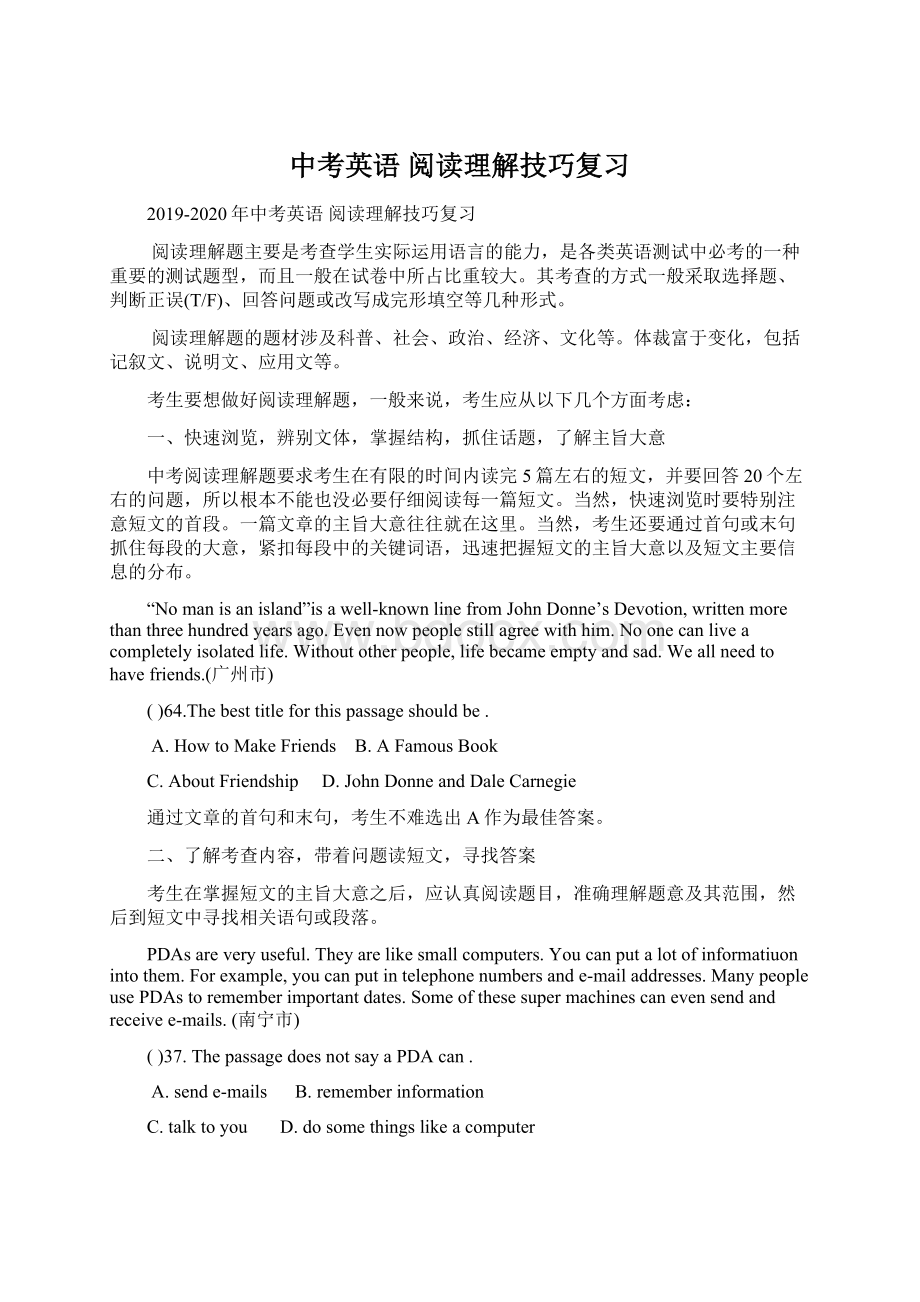中考英语 阅读理解技巧复习.docx
《中考英语 阅读理解技巧复习.docx》由会员分享,可在线阅读,更多相关《中考英语 阅读理解技巧复习.docx(17页珍藏版)》请在冰豆网上搜索。

中考英语阅读理解技巧复习
2019-2020年中考英语阅读理解技巧复习
阅读理解题主要是考查学生实际运用语言的能力,是各类英语测试中必考的一种重要的测试题型,而且一般在试卷中所占比重较大。
其考查的方式一般采取选择题、判断正误(T/F)、回答问题或改写成完形填空等几种形式。
阅读理解题的题材涉及科普、社会、政治、经济、文化等。
体裁富于变化,包括记叙文、说明文、应用文等。
考生要想做好阅读理解题,一般来说,考生应从以下几个方面考虑:
一、快速浏览,辨别文体,掌握结构,抓住话题,了解主旨大意
中考阅读理解题要求考生在有限的时间内读完5篇左右的短文,并要回答20个左右的问题,所以根本不能也没必要仔细阅读每一篇短文。
当然,快速浏览时要特别注意短文的首段。
一篇文章的主旨大意往往就在这里。
当然,考生还要通过首句或末句抓住每段的大意,紧扣每段中的关键词语,迅速把握短文的主旨大意以及短文主要信息的分布。
“Nomanisanisland”isawell-knownlinefromJohnDonne’sDevotion,writtenmorethanthreehundredyearsago.Evennowpeoplestillagreewithhim.Noonecanliveacompletelyisolatedlife.Withoutotherpeople,lifebecameemptyandsad.Weallneedtohavefriends.(广州市)
()64.Thebesttitleforthispassageshouldbe.
A.HowtoMakeFriendsB.AFamousBook
C.AboutFriendshipD.JohnDonneandDaleCarnegie
通过文章的首句和末句,考生不难选出A作为最佳答案。
二、了解考查内容,带着问题读短文,寻找答案
考生在掌握短文的主旨大意之后,应认真阅读题目,准确理解题意及其范围,然后到短文中寻找相关语句或段落。
PDAsareveryuseful.Theyarelikesmallcomputers.Youcanputalotofinformatiuonintothem.Forexample,youcanputintelephonenumbersande-mailaddresses.ManypeopleusePDAstorememberimportantdates.Someofthesesupermachinescanevensendandreceivee-mails.(南宁市)
()37.ThepassagedoesnotsayaPDAcan.
A.sende-mailsB.rememberinformation
C.talktoyouD.dosomethingslikeacomputer
通过分析四个选择支,考生不难发现A、B、D分别体现在文章最后一句、第三句和第二句。
故本题应选C。
三、认真斟酌,透过表层结构,领会其深层涵义
找到相关语句或段落后,考生要对所选答案有针对性地寻找支撑论点的关键信息,弄清楚短文中的一些重要事实或细节,因为它们是作者得出结论或阐明论点的依据。
考生要对这一部分内容仔细阅读,反复推敲,从而保证对这一细节的正确理解。
In Sri Lanka, when the first waves hit, thousands of children came to the seaside. The
waves brought in fish. The old and the young collected them. Many waited for more.
“They got caught and could not run to safety. This is the reason why so many children
have died,” said a police spokesman in Sri Lanka.(盐城市)
( ) 73. Many children died in tsunamis because_____________.
A.they were near the sea every day B. they didn't know when to run away
C. they were waiting to collect fish D. they were playing on the sand
考生初一看,A、B、C、D四个选择支在文中均提到,但只要仔细推敲一下那位警察发言人的话,就可以确定C为最佳答案。
四、筛选、比较、衡量、综合文章的有用信息,确定最佳答案
做完一篇短文后面的所有题目后,考生要对照短文内容通盘考虑,充分分析前后的内在联系,理顺全文的逻辑关系,从而尽可能可以减少错误或疏漏。
OneautumnafternoonThefifthhurricane(飓风)oftheyear-----HurricanePaula,whichwasmovingataspeedofmorethanthirty-fivemilesanhour,didhitPohawk.Thistimeitlastednearlyfivehoursandkilledatleast2637men,womenandchildren.Thelistofmissingpeoplegotlongereveryday.NearlyhalfofthepeopleofPohawkweremissing.Itdestroyed(摧毁)everythinginthetownandcausedgreatfloodsturningthesmalltownintoisland.Thetopofthehoteldisappearedandsodidthegreatmansion(大厦).TheradiotowerhadfallenonPohawk’sonlyfactoryandcutitinhalf.(泰州市)
()61.Thepassagemainlytellsus_____.
A.thegreatnumberofthelostpeople
B.thegreatspeedofHurricanePaula
C.thegreatdamagecausedbyHurricanePaula
D.thegreatfloodscausedbyahurricane
综合分析文中所提供的信息:
飓风的巨大风速、死亡的人数、巨大的财产损失等,考生便可找出C为最佳答案。
2019-2020年中考英语阅读题型一完形填空
01命题趋势考标导向化
1.考查内容
完形填空是全国各省、地、市中考的必考题型,在中考英语试卷中一般占总分的10%—15%。
从近几年的中考命题趋势来看,完形填空基本上遵循“突出语篇,强调应用,注重实际”的设计思路,注重测试考生运用所学的知识,对文章提供的信息进行逻辑推理、分析归纳的综合能力。
完形填空考查考生对语法、词汇、句型、句式、词语惯用法等的掌握情况,特别是考查动词、名词、形容词、副词等实词,此外还有状语从句的连接词、词组搭配及常用的词语、冠词、不定代词等。
2.考查难度
完形填空题型综合性较高,难度较大。
具体地说,虽然完形填空首句不挖空,但是四个选项(个别试题给出三个选项)都有较强的迷惑性和干扰性,同时命题者加大了句子层次和语篇层次设空所占的比例,有些后置性设空的难度也较大,有的答案提示一直到篇末才出现,因此区分度较高。
3.试题特点
完形填空的基本设计形式都是从一篇短文中抽走10—15处,形成空白。
可以说完形填空是根据一篇文章所提供的情景进行的选择填空,也可以说它是在缺少个别单词情况下的阅读理解,试题特点也逐渐出现了“情景推理多,语法选项少”的趋势。
近年中考英语完形填空试题中,完全根据语法知识进行选择的很少。
有的题目,既考查语法知识,也考查意义选择,而且淡化语法知识,侧重根据文章内容确定答案的“情景意义”选择几乎已经覆盖了完形填空的全部试题。
预计2015年中考完形填空题将继续体现“突出语篇”的命题原则,即“意义填空逐步取代语法填空”,题材和体裁的选取会更加生活化、多样化,选材内容新颖,时代感强,更加注重贴近学生的生活实际。
加大对文章的结构意义、上下文衔接、逻辑思维等内容的考查,将是中考完形填空的命题趋势。
02方法归纳能力提升化
1.重视首句,把握开篇
完形填空一般无标题,首句通常不挖空,是完整的一句。
细读首句,可判断文章体裁,同时可预测文章的主旨和大意。
2.通读全文,掌握大意
解题前,要快速通读全文,了解文章的基本内容和整体结构。
首先要跳过空白处,通读全文,遇到对意思理解不透的地方时,仍要快速阅读下去,不要把时间浪费在对个别字句的推敲上,应全力以赴捕捉可能获得的所有信息,尽快了解文章大意,弄清楚文章中涉及的“W”,即:
who(人物),what(事件),when(时间),where(地点),why(原因),whose(相互关系)。
切忌看一空填一空,以免断章取义,误解作者的本意。
3.瞻前顾后,逐步填空
“瞻前顾后”,即答题时要回顾上一句,兼顾下一句。
如果一句中有两个空白处待填,在初定答案时要“双管齐下”,在两处同时试填,然后通读全句,通过择优法或排除法最后确定答案。
4.抓住关键词,根据上下文解题
解题时,要善于发现文章中起重要作用的关键词、短语或句子,以便准确了解所提问题的特定语境以及语篇中的内在关系,做到言之有据。
比如文章的第一句、每段的第一句和最后一句等,它们往往是全文或全段的主题句,通过它们可以知道文章的题材、大意、时间、人物和事件等。
5.复读全文,验证答案
把填好的短文通读一遍,将不合题意的答案调整或修改;如果实在无法确定,可以作推理性猜测,不可放弃不填。
进行核查同时注意以下三点:
(1)上下文的一致性:
即时态语态的一致;代词、名词、单复数的一致。
(2)语法和惯用法及习惯搭配,甚至从语感入手,看是否符合上下文的逻辑。
(3)段与段、句与句之间的衔接是否连贯。
03整合集训反馈层级化
▲记叙篇
A(2014·镇江)
Recently,IfeltlikeIreachedaverylowpointinlife.Myrelationshipsweren’tgood,Iwasn’tenjoyingmyclasses,andIfeltlikeIhadnothingto1.Mylifeseemedtobefullofendlesshomework,testsandloneliness.Nothinganyonesaidseemed2tome.Iwasn’tsurewhattodoaboutmyself.AllIwantedwastobehappyagain,butIdidn’tknowwhoorwhatwould3that.
Duringthesedays,Ihadtroublesleeping.Ihadtotakesleepingpillsbutstillwokeupinthemidnight.Ihadno4buttotellmydad.He5thebookTheSecret.Iimmediatelyboughtthee-bookonlineandreadthewholethingthatnight.I’m6quiteastubbornperson,buttheeffectonmymoodafterfinishingthebookwas7.Suddenly,Ifeltlikelifewasbeautifulagain.Ihadneverfeltsuchadeepandquick8inmylifebefore.
Infact,thebook’smessagewasverysimple—thinkpositively(积极地).Thebookhadmanysuccessstoriesabouthowpeoplewereableto9money,soulmates(心灵伙伴)andoldfriendsbackintotheirlives.Istartedlearningtothankeverythinginmylifelikethem.Littlebylittle,IrealizedthatTheSecretcouldonlywork10Ibelievedthesepeople’ssuccessstories.
NowI’msureIcanbringmyselfhappiness.
()1.A.takecareofB.comeupwith
C.lookdownonD.lookforwardto
()2.A.helpfulB.colourful
C.peacefulD.powerful
()3.A.serveB.offer
C.answerD.prevent
()4.A.problemB.idea
C.needD.doubt
()5.A.borrowedB.collected
C.returnedD.recommended
()6.A.normallyB.mainly
C.finallyD.probably
()7.A.realisticB.common
C.obviousD.serious
()8.A.breathB.notice
C.surpriseD.change
()9.A.attractB.control
C.imagineD.mention
()10.A.untilB.when
C.unlessD.before
B(2014·安徽)
OncetherelivedafarmercalledHenry.Hehadabrother,Mike,intownwhowasanexcellentgardener.Hisskillandhisbeautifultreeswere1everywhere.
Oneday,HenrywenttotowntovisitMike.“Look,mybrother,”saidMike,“Hereisthebest2treefrommygarden.Takeithomeand3itsothatyou,andyourchildren,andyourchildren’schildrencanenjoyit.”Henrywas4withtheappletreeandwentbackhome.Thenextmorning,hebeganto5whereheshouldplantit.
“IfIplantitonthehill,”saidhetohimself,“thewindmightcatchitand6downthefruit;IfIplantitclosetotheroad,peoplewhopassbywillpicksomeofthem;ButifIplantit…”
7heplantedthetreeinthecornerbehindhishouse,wherenooneelsecouldnoticeit.Butthetreebore(结出)nofruitthefirstyear,northesecond.ThenHenrysentforhisbrotherandsaidtohim8,“Youhavecheatedme.Thisisthethirdyearanditbringsme9butleaves.”
WhenMikesawwherethetreewasplanted,helaughedandsaid,“Youhaveplantedthetreeinsuchacoldcornerwithout10orwarmth.How,then,couldyouexpectflowersandfruit?
”
()1.A.simpleB.famous
C.similarD.common
()2.A.pearB.grape
C.appleD.banana
()3.A.sellB.wash
C.hideD.plant
()4.A.tiredB.patient
C.pleasedD.popular
()5.A.learnB.wonder
C.realizeD.understand
()6.A.putB.cut
C.pushD.shake
()7.A.FinallyB.Firstly
C.LuckilyD.Certainly
()8.A.happilyB.angrily
C.kindlyD.carelessly
()9.A.nothingB.something
C.everythingD.anything
()10.A.airB.earth
C.waterD.sunlight
C(2014·河南)
“It’srainingcatsanddogs!
”Grandpashouted.
LittleRichiecamerunningtothewindow.Hewantedtoseethe1fallingfromthesky.Helookedoutofthewindow,butitwas2thattherewerenocatsordogs.Heonlysawsmallpoolsofwaterontheground.
“Man,it’sreallycomingdownoutthere!
”UncleBobagreed3helookedoutofthewindow,too.Richiescratchedhishead(挠头).Whatwascomingdown?
Firsttheytalkedaboutcatsanddogsthat4beseen.Nowsomeonesaid“it”.Whatwasgoingonwiththese5?
“Wow!
”AuntSusieshoutedasshelookedoutofthewindow.“It’srainingreallyhard.”
Richie6hisaunt.“It’sraininghard,”heagreed,“but7arethecatsanddogs?
”
Grandpalaughed.“Richie,thatjust8it’srainingreallyhard.”
“Sowhydidn’tyoujustsaythat?
”Richie9.Itwasirritating(恼人的)whenpeoplespokeliketheywerenotspeakingEnglishatall.
“Wedid.Youjustdidn’tunderstandthese10.”Richie’scousinsaidwithabigsmile.
“Well,nowIdo.”Richiesaid.
()1.A.tigersandlionsB.pigsandsheep
C.catsanddogsD.chickensandducks
()2.A.importantB.possible
C.necessaryD.strange
()3.A.unlessB.after
C.tillD.though
()4.A.couldn’tB.shouldn’t
C.needn’tD.mustn’t
()5.A.daysB.animals
C.ideasD.people
()6.A.shoutedatB.lookedat
C.laughedatD.pointedat
()7.A.whatB.how
C.whereD.who
()8.A.explainsB.proves
C.meansD.shows
()9.A.orderedB.thought
C.repeatedD.asked
()10.A.sayingsB.questions
C.objectsD.stories
▲说明篇
A(2014·曲靖)
Insomesciencefictionmovies,peopleinthefuturehavetheirownrobots.Theserobotsarejustlikehumans.Theyhelpwiththehouseworkanddothemost1jobs.
Somescientistsbelievethattherewillbesuchrobotsinthefuture.However,theyagreeitmaytakehundredsofyears.Scientistsarenowtryingtomakerobotslooklikepeopleand2thesamethingsasus.Japanesecompanieshavealreadymaderobotswalkanddance.Thiskindofrobotwillalsobefuntowatch.
ButrobotscientistJamesWhitedisagrees.Hethinksthatitwillbe3fora